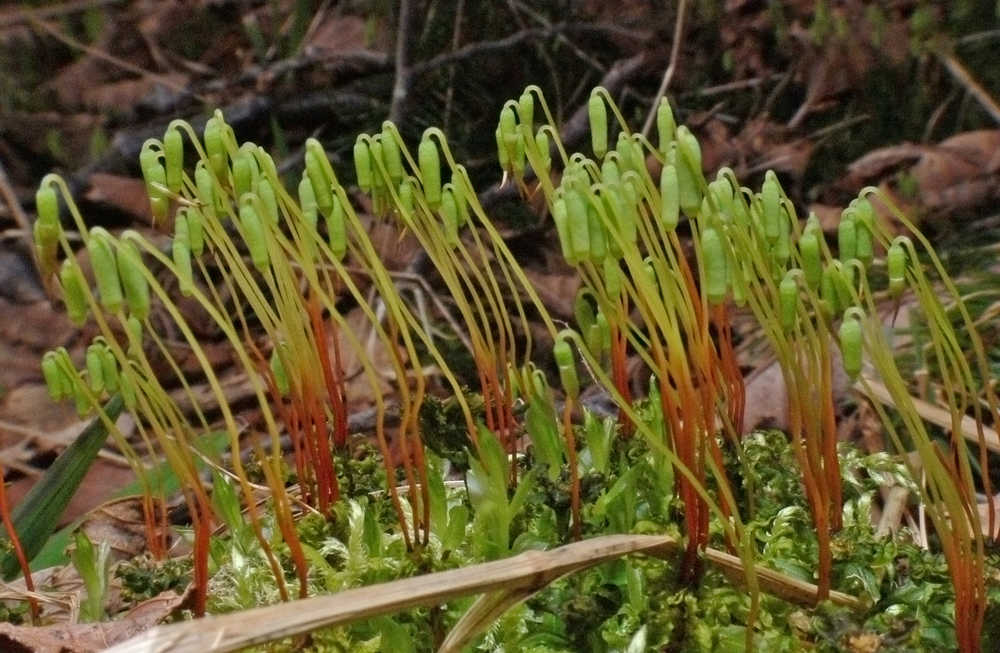All plants need to produce offspring and those offspring need to be sent out into the world to get established and grow up to make offspring of their own. Although the mother plant that produces the offspring clearly landed in a suitable site, it often happens that plant eaters concentrate their foraging on areas of higher density, so that is one good reason to for the offspring to colonize a new place. Competition among offspring can also favor spreading out to new sites, where competition with siblings is less.
Dispersal is always a risky business, and by far the great majority of young ones die. Although some plants produce “bulbils” (think of tiger lilies, anderson’s sword fern) on leaves or stems, the bulb-like structures are not generally capable of dispersing much beyond the base of the parent plant, so they seldom reach new sites.
For dispersal farther from the parent plant, plants typically use spores or seeds. What is the distinction?
A spore is defined in my big dictionary as a small entity with a tough covering that’s resistant to environmental extremes; it is often a single cell but in some cases it has several cells. When conditions are right, a spore can germinate, producing a new individual, which may come from sexual reproduction (union of sperm and egg to form a zygote) or more commonly from asexual reproduction (mere cell division). Being tough and resistant means that a spore can sit around for a considerable time, waiting for the right conditions for germination. In effect, this is dispersal in time. However, such very small entities generally also have the capacity to disperse in space — moved about by currents of air or water. (There is at least one exception, of course: for instance, the spores of truffle fungi are dispersed by squirrels that eat the fungus and excrete viable spores.)
Spores are produced by algae, fungi, mosses and ferns, and their allies. One sees the spore-bearing structures of fungi in the form of mushrooms and conks (such as “bear-bread”), of mosses in the tiny, stalked capsules borne by the moss plant, and of ferns in the arrays of small discs on the backs of the fronds (or, in some species, such as deer fern, on a separate frond).
In contrast, all the familiar conifers and flowering plants produce seeds, usually by sexual reproduction. A seed typically contains stored food for the embryo, giving it a head start in growth after the seed germinates. (There’s an exception here too, of course: orchid seeds have no stored food and depend on special, mycorrhizal fungi for germination and initial growth.) The stored food supplies are derived from maternal tissues in the conifers, but in the flowering plants, they derive from the joining of nuclei from male and female parents (one set of nuclei forms the zygote, and others make the storage product). A seed has a protective coat of maternal tissues that enclose both embryo and storage products.
Seeds, like spores, can in some species lie dormant, awaiting the right conditions, thus dispersing in time. Many kinds of seeds have special adaptations for dispersal in space: fleshy fruits (such as blueberries, strawberries) to be eaten by animals that excrete viable seeds, wings or plumes (such as those on fireweed) to carry the seeds on the wind, explosive capsules (such as those on lupine) that shoot the seeds away from the parent, hooks (such as those of buttercups) that stick to fur or socks, and so on.
Both spores and seeds can accomplish dispersal in space and in time. Spores were around for a long time before seeds evolved and did (as they still do) the job of dispersal for fungi, mosses and ferns. Yet the seed-producing plants have become the dominant form of plant life over much of the earth’s land surface. We can then ask if the evolution of seeds somehow allowed plants to exploit new ways of life, leading to the great diversity of seed-bearing plants that now inhabit the land. Or did the environment change in some way that made it advantageous for plant offspring to start off with the support of stored food?
• Mary F. Willson is a retired professor of ecology.

